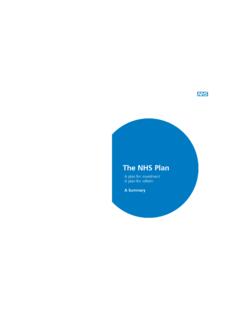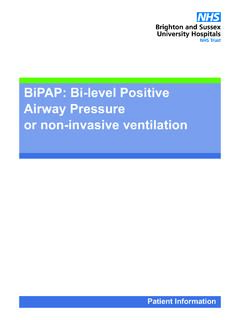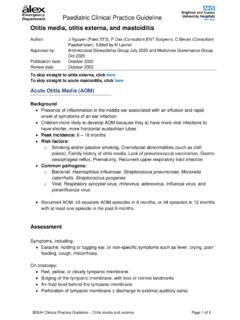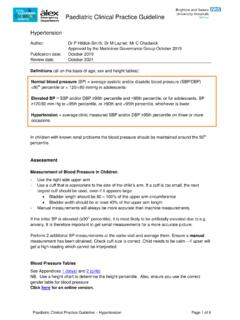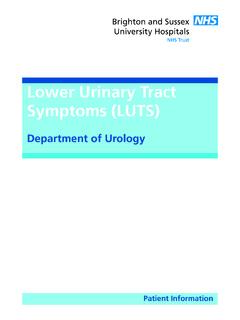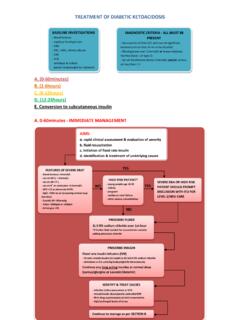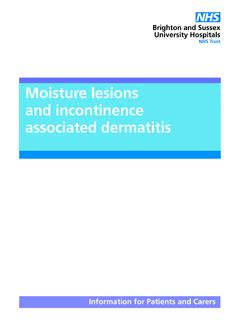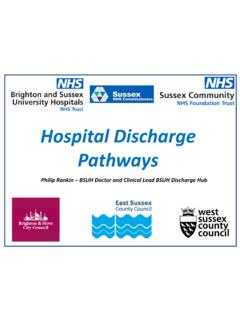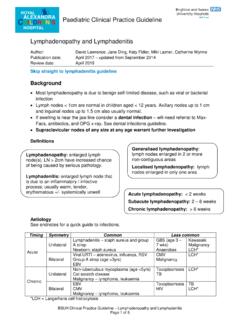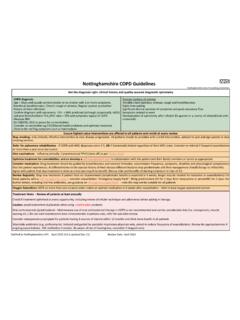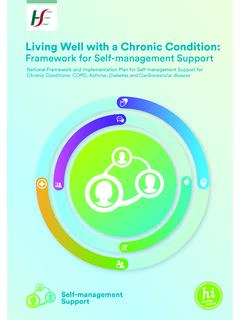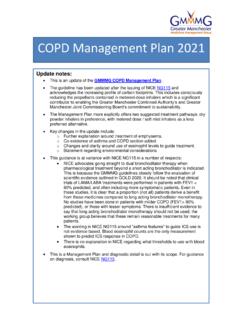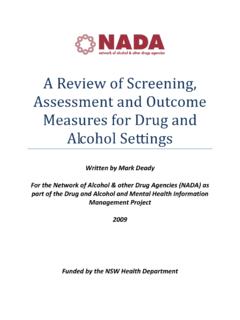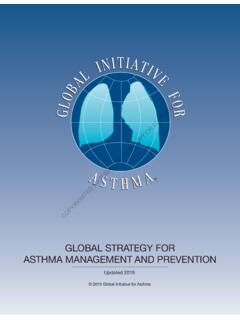Transcription of British guideline on the management of asthma
1 EvidenceQRG 153 British guideline on the management of asthmaQuick Reference GuideSeptember 2016 British Thoracic SocietyScottish Intercollegiate guidelines NetworkBritish guideline on the management of asthmaQuick Reference GuideRevised September 2016 ISBN 978 1 909103 48 1 First published 2003 Revised edition published 2016 SIGN and the BTS consent to the photocopying of this QRG for the purpose of implementation in the NHS in England, Wales, Northern Ireland and Thoracic Society17 Doughty Street, London WC1N 2PL Intercollegiate guidelines Network Gyle Square, 1 South Gyle Crescent, Edinburgh EH12 9EB Quick Reference Guide provides a summary of the main recommendations in SIGN 153 British guideline on the management of are graded A B C D to indicate the strength of the supporting practice points are provided where the guideline development group wishes to highlight specific aspects of accepted clinical of the evidence supporting these recommendations can be found in the full guideline , available on the SIGN website: This Quick Reference Guide is also available as part of the SIGN guidelines fromAndroid Market1 Applies to children 1 Applies only to adultsApplies to children 5-12 Applies to children under 5 GeneralApplies to adolescentsDIAGNOSISDEFINITIONThe diagnosis of asthma is a clinical one.
2 The absence of consistent gold-standard diagnostic criteria means that it is not possible to make unequivocal evidence-based recommendations on how to make a diagnosis of to all definitions is the presence of symptoms (more than one of wheeze, breathlessness, chest tightness, cough) and of variable airflow obstruction. More recent descriptions of asthma in both children and adults have included airway hyper-responsiveness and airway inflammation as components of the the results of diagnostic tests undertaken whilst a patient is asymptomatic with those undertaken when a patient is symptomatic to detect variation in symptoms over CONCEPTS yTests influence the probabilty of asthma but do not prove a diagnosis yAsthma status and the outcome of diagnostic tests for asthma vary over timePRACTICAL APPROACH TO DIAGNOSISThe diagnosis of asthma in children and adults is based on the recognition of a characteristic pattern of respiratory symptoms.
3 Signs and test results and the absence of any alternative explanation for to children 1 Applies only to adultsApplies to children 5-12 Applies to children under 5 GeneralApplies to adolescentsDIAGNOSTIC ALGORITHMP resentation with respiratory symptoms: wheeze, cough, breathlessness, chest tightness1 High probabilityof asthmaCode as:suspected asthmaInitiation of treatmentAssess response objectively(lung function/validated symptom score)Good responseAsthmaAdjust maintenance dose. Provide self - management adviceArrange on-going reviewIntermediate probability of asthmaTest for airway obstructionspirometry + bronchodilator reversibilitySuspected asthma :Watchful waiting (if asymptomatic)or Commence treatment andassess response objectivelyGood responseOther diagnosisconfirmedInvestigate/treat for other more likely diagnosisOther diagnosis unlikelyLow probability of asthmaPoor responsePoor responseOptions for investigations are:Test for variability: reversibility PEF charting challenge testsTest for eosinophilic inflammation or atopy.
4 FeNO blood eosinophils, skin-prick test, IgE1 In children under 5 years and others unable to undertake spirometry in whom there is a high or intermediate probability of asthma , the options are monitored initiation of treatment or watchful waiting according to the assessed probabilityof clinical assessment (from history and examination of previous medical records) Look for: recurrent episodes of symptoms recorded observation of wheeze symptom variability personal history of atopy absence of symptoms of alternative diagnosis historical record of variable PEF or FEV13 Applies to children 1 Applies only to adultsApplies to children 5-12 Applies to children under 5 GeneralApplies to adolescentsDIAGNOSISThe predictive value of individual symptoms or signs is poor, and a structured clinical assessment including all information available from the history, examination and historical records should be undertaken.
5 Factors to consider in an initial structured clinical assessment include:Episodic symptomsMore than one of the symptoms of wheeze, breathlessness, chest tightness and cough occurring in episodes with periods of no (or minimal) symptoms between episodes. Note that this excludes cough as an isolated symptom in children. For example: y a documented history of acute attacks of wheeze, triggered by viral infection or allergen exposure with symptomatic and objective improvement with treatment y recurrent intermittent episodes of symptoms triggered by allergen exposure as well as viral infections and exacerbated by exercise and cold air, and emotion or laughter in children yin adults, symptoms triggered by taking non-steroidal anti-inflammatory medication or beta historical record of significantly lower FEV1 or PEF during symptomatic episodes compared to asymptomatic periods provides objective confirmation of obstructive nature of the episodic confirmed by a healthcare professional on auscultation y It is important to distinguish wheezing from other respiratory noises.
6 Such as stridor or rattly breathing. yRepeatedly normal examination of chest when symptomatic reduces the probability of of diurnal variabilitySymptoms which are worse at night or in the early historyPersonal history of an atopic disorder (ie, eczema or allergic rhinitis) or a family history of asthma and/or atopic disorders, potentially corroborated by a previous record of raised allergen-specific IgE levels, positive skin-prick tests to aeroallergens or blood of symptoms, signs or clinical history to suggest alternative diagnoses (including but not limited to COPD, dysfunctional breathing, obesity).INITIAL STRUCTURED CLINICAL ASSESSMENT4 Applies to children 1 Applies only to adultsApplies to children 5-12 Applies to children under 5 GeneralApplies to adolescentsDIAGNOSISASSESS PROBABILITY OF asthma BASED ON INITIAL STRUCTURED CLINICAL ASSESSMENTA dults and children with a typical clinical assessment including recurrent episodes of symptoms ( attacks ), wheeze heard by a healthcare professional, historical record of variable airflow obstruction and a positive history of atopy and without any features to suggest an alternative diagnosis have a high probability of asthma .
7 In patients with a high probability of asthma : y record the patient as likely to have asthma and commence a carefully monitored initiation of treatment (typically 6 weeks of inhaled corticosteroids) y assess status with a validated symptom questionnaire and/or lung function tests (FEV1 at clinic visits or by domiciliary serial peak flows) y with a good symptomatic and objective response to treatment, confirm the diagnosis of asthma and record the basis on which the diagnosis was made y if response is poor or equivocal, check inhaler technique and adherence, arrange further tests and consider alternative diagnoses. If there is a low probability of asthma and/or an alternative diagnosis is more likely, investigate for the alternative diagnosis and/or undertake or refer for further tests of , with bronchodilator reversibility as appropriate, is the preferred initial test for investigating intermediate probability of asthma in adults, and in children old enough to undertake a reliable test.
8 In adults and children with an intermediate probability of asthma and airways obstruction identified through spirometry, undertake reversibility tests and/or a monitored initiation of treatment assessing the response to treatment by repeating lung function tests and objective measures of asthma control. In adults and children with an intermediate probability of asthma and normal spirometry results, undertake challenge tests and/or measurement of FeNO to identify eosinophilic inflammation. In children with an intermediate probability of asthma who cannot perform spirometry: yconsider watchful waiting if the child is asymptomatic yoffer a carefully monitored trial of treatment if the child is PROBABILITYLOW PROBABILITYA dults and children who do not have any of the typical features on initial structured clinical assessment or who have symptoms suggestive of an alternative diagnosis have a low probability of PROBABILITYA dults and children who have some, but not all.
9 Of the typical features of asthma on an initial structured clinical assessment or who do not respond well to a monitored initiation of treatment have an intermediate probability of to children 1 Applies only to adultsApplies to children 5-12 Applies to children under 5 GeneralApplies to adolescentsDIAGNOSISDIAGNOSTIC INDICATIONS FOR REFERRALAt any point in the diagnostic algorithm, there may be a need for referral for additional investigations and/or specialist advice. Some key indications for referral to specialist care:ADULTSCHILDRENR eferral for tests not available in primary careDiagnosis unclearDiagnosis unclearSuspected occupational asthma (symptoms that improve when patient is not at work, adult-onset asthma and workers in high-risk occupations)Poor response to asthma treatmentPoor response to monitored initiation of asthma treatmentSevere/life-threatening asthma attackSevere/life-threatening asthma attack Red flags and indicators of other diagnosesProminent systemic features (myalgia, fever, weight loss)Failure to thriveUnexpected clinical findings (eg crackles, clubbing, cyanosis, cardiac disease, monophonic wheeze or stridor)
10 Unexplained clinical findings (eg, focal signs, abnormal voice or cry, dysphagia, inspiratory stridor)Persistent non-variable breathlessnessSymptoms present from birth or perinatal lung problemChronic sputum productionExcessive vomiting or possetingUnexplained restrictive spirometrySevere upper respiratory tract infectionChest X-ray shadowingPersistent wet or productive coughMarked blood eosinophilia Family history of unusual chest diseaseNasal polypsPatient or parental anxiety or need for reassuranceORGANISATION OF DIAGNOSTIC SERVICESCS treamlined referral pathways should be developed for tests not available or appropriate in primary to children 1 Applies only to adultsApplies to children 5-12 Applies to children under 5 GeneralApplies to adolescentsAAll people with asthma (and/or their parents or carers)
